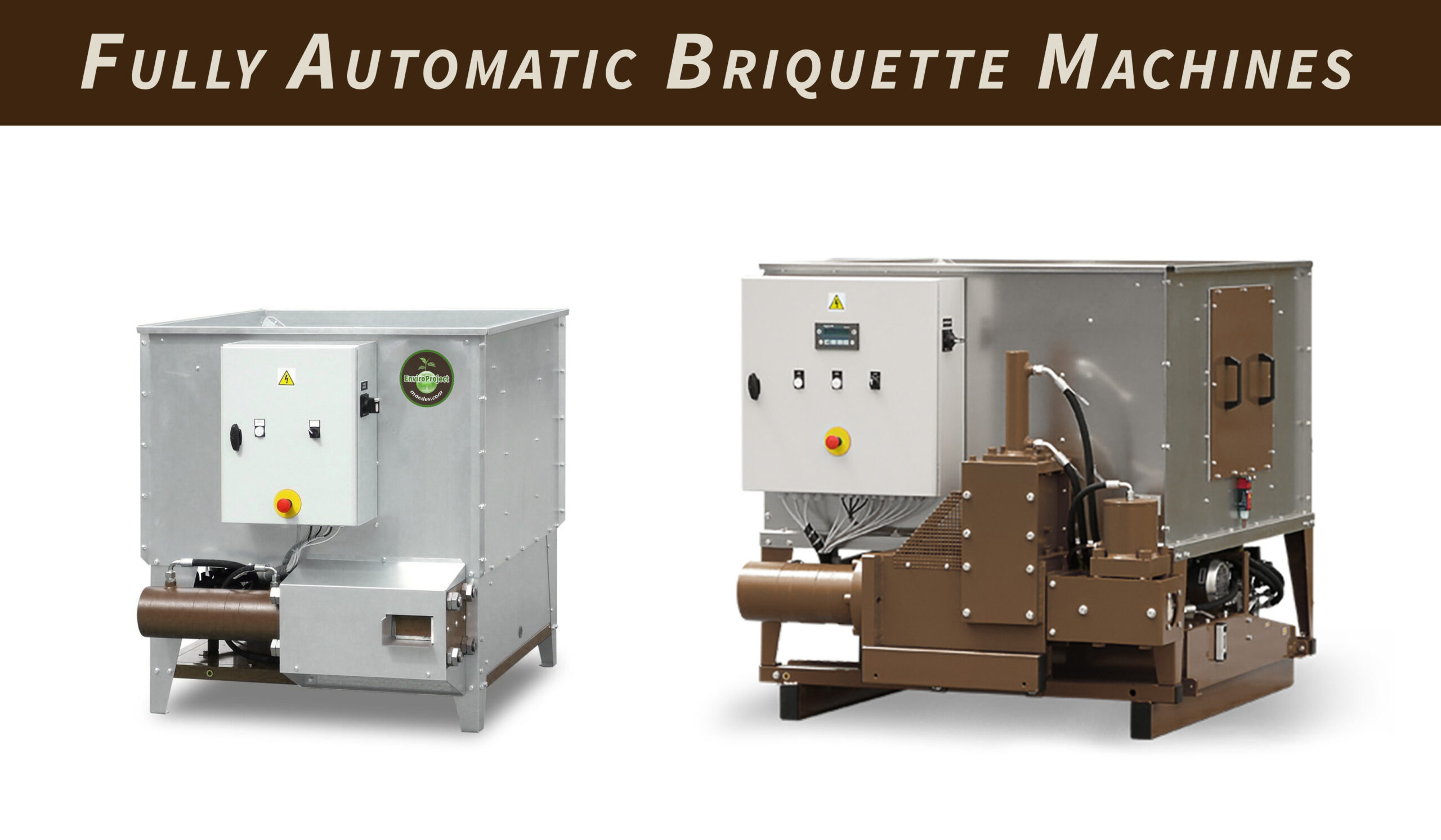What briquette machine is best for you
It may not be easy to know from the get-go what briquette maker is the most suitable one for your needs.
Therefore we’ve created this simple guide to help you determine which briquette press is the right one for you:
Briquette machine / press machine guide
The best place to start is to take a look at your waste material and answer these questions:
1. How much of the waste material do you produce (i.e. needs to be processed) per day or per week?

This will help to determine what speed of briquetting you will need which, in turn, will narrow down the selection of briquette machines.
We normally work with weight but it can also be estimated per cubic metre or per standard extractor bag depending on the character of the material.
If it is pure sawdust / fine particles:
1m3 would be around 120kg;
1 standard extractor bag around 30kg.
If it is just shavings / larger lightweight particles:
1m3 would be around 70kg;
1 standard extractor bag around 15kg.
If it is a mixture, then the weight will be somewhere in between, subject to the ratio of shavings to sawdust.
Another important thing to bear in mind is a possible increase in those quantities in the near future. Even though you can always upgrade and trade in your old briquette machine (as long as it was bought from us), it is best to opt for a machine that is slightly faster than you need in order to avoid overworking a slower system.
2. What does your waste consist of?

Do you have multiple materials to process or just one? If multiple, are they separated or mixed randomly?
The reason for these questions is that there are two main types of presses:
Fully automatic briquette machines
These are more suitable if you have multiple materials, in random mixtures especially. These briquetters will adjust their settings automatically based on how the material character / particle size changes and will produce the best briquettes possible within their technical limits.
See the fully automatic briquette machines by clicking on this line or the picture below:
More hands-on briquette makers (but better speed / cost ratio)
These briquetters normally require a change of their settings, depending on the material or the mixture of different materials. The settings are normally pressure / friction as the new briquette is pressed against the already existing briquette moving forward whether it is a screw-type or mechanical briquette machine. Most of these machines are also equipped with an external heater element to aid the compression process / release of natural binders in the material. These machines generally also require more maintenance and/or changing wear-and-tear parts regularly so this is also something to factor in when making the decision.
See the more hands-on briquette machines by clicking on this line or the picture below:
And then, there is the in-between – affordable machines that come without wear-tear-parts to change regularly, not fully automatic but still, they don’t require an operator to stand over them at all times.
Unique combination of added heat and hydraulic pressing system allows for producing briquettes of comparable quality to larger and more expensive machinery. In some instances, for example MDF and similar materials on their own result in even longer lasting and more dense briquettes when produced on the smallest, PH briquette machine than when those materials are used in other, larger machines.
Find out more about the affordable briquette machines by clicking on this line or the picture below:
The best briquette system for you in this respect is the one that fits your workflow. The more hands-on briquetters need more attention and overseeing but they are very capable and much better value in relation to the output rate. The fully automatic briquette machines are, on the other hand, more expensive but they save time and labour. The more affordable briquette machines are a very good starting point and oftentimes sufficient enough for smaller operations.
3. What is the particle size of your waste material?

This ties in with the first question about finding out how fast of a machine would be best for you.
The particle size impacts the weight of your bags but also the output rate on certain briquette machines.
The important thing to note is the output rates will be below average when processing materials consisting of larger / more lightweight particles (shavings, straw, shredded cardboard, paper, etc.) on the entry models like the single-phase PH briquette machine or the compact A-TYPE 30 briquette machine.
Where this doesn’t play a significant role is using machines with more efficient feeding system like the A-TYPE 40,60 or 80 briquette machines, PHM600 Mechanical briquette / pellet machine or Agro and Agroline briquette machines.
If the particle size exceeds the general input material criteria for briquetting, i.e. particle size smaller than 1 or 1.5 cm, subject to the machine used (or smaller than 6mm for pellet machines), then the material may have to be reduced down in size. We offer pre-processing machinery for this – V-shredders for larger offcuts, boards, pallets, etc., capable of shredding and milling to suitable size for a briquette machine.
4. What is the moisture content of the material?

Apart from particle size input material criteria, there is another important one to consider – moisture content. This should be below 20% or even below 15%, subject to the briquette machine and character of the material.
If the moisture content in your material exceeds the limits above, it may have to be reduced down. We offer pre-processing machinery for this too – cabinet or rotary dryers, depending on the required speed of drying.
If this was helpful, let us know or contact us if you have any questions and want to discuss your needs and wants with us. We look forward to hearing from you:
MAE Development
71-75 Shelton Street
London
England
WC2H 9JQ
United Kingdom








